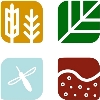PhenoRob
The overarching research question in CP5 is how crop diversification implemented at different temporal and spatial scales (extent and resolution) affects the multifunctional response of agroecosystems (e.g. in terms of crop growth, yield, input reduction, resource use and use efficiency and biodiversity). The possibilities and impacts of new technologies (esp. with respect to sensing and robotics) are evaluated from three perspectives: crop physiological, ecological (including soil and biodiversity) and technological.
The development of new light-weight robotic field technology offers the possibility to considerably decrease field sizes, and to reshape field geometries, because the new machinery can potentially deal with variable field sizes, shapes and different crop species and do not require large rectangular fields. Crop management can therefore be adapted to exploit spatial heterogeneity of the growing conditions, in particular of the soil, thereby improving resource use efficiency and enhancing spatial and temporal crop diversity in the field. In CP5.2, spatio-temporal adapted management will focus on the choice of crop species and their spatial allocation and temporal sequences (rotations) as a function of soil heterogeneity, which also implies spatially heterogeneous crop management (e.g. tillage, sowing) including input regimes (e.g. with regard to fertilization and plant protection). However, it is currently unknown how these envisaged changes will affect the agroecosystem performance in terms of (a) competition and neighbour effects; (b) actual effects on adaptation, resource conservation and resource use efficiencies; (c) biotic interactions, e.g. with respect to plant disease epidemiology or biodiversity effects.
Connection with overall
PhenoRob objectives:
CP5 is involved in the themes ROBSENSE, CROP, ECO, UPSCALE and mainly contributes to PhenoRob objectives by:
- Application of new sensing techniques in innovative mixed and patched cropping systems.
- Environmental and biodiversity monitoring in novel cropping systems.
- Develop management suggestions for diversified cropping systems.
PhenoRob CP5.2 - New Field Arrangements
The use of agro-ecosystem models is an important tool to explore crop and ecosystems dynamics as they offer the flexibility in which we can explore system responses in a range of environments and management practices. Because of this, they can be used as a complementary tool to field arrangement experiments in the field.

Ixchel Hernandez-Ochoa, a postdoc at the University of Bonn is part of the CP5.2 project and her main objective is to develop and apply agro-ecosystem models using the SIMPLACE modeling framework, to explore the dynamics and impacts of diversified cropping systems adapted to spatial soil heterogeneities (e.g. patchy crops), on multifunctional agroecosystem performance and to further explore their impacts at local and regional scale.
The specific objectives of this project are: i) to develop and apply agro-ecosystem modelling tools to study the impacts of diversified cropping systems on ecosystem services and resource use efficiency, ii) To gain mechanistic insights into scale-dependent effects of crop diversification on agroecosystem performance and ii) To demonstrate and evaluate the possibilities of new digitally based technologies combined with crop modelling, remote sensing and machine learning to implement and manage sustainable new site-adapted field arrangements.
The SIMPLACE modelling framework has been used to calibrate and validate an agroecosystem model using crop growth and management data, that was collected at the patchCROP experiment. This model can now serve as a tool to better understand and design diversified cropping systems and evaluate them regarding the provision of ecosystems services. Furthermore an intensive soil sampling campaign was conducted to gain insights into the soil heterogeneity at the experimental site, since these impact the water holding capacity of the soil and consequently crop growth dynamics. We also aim to use the model as a tool to design and evaluate spatially adapted management in terms of crop rotation and crop management in respect to the diverse soil characteristics. Therefore, an additional analysis regarding the model's ability to simulate soil water dynamics has been carried out, which showed that the model is able to capture the seasonal water dynamics of the diversified cropping system under heterogeneous soil conditions. In the next steps a combination of agroecosystem models and soil zones derived from proximally sensed soil data (research by Prof. Huismann and Salar Saaed, FZJ) will be used to optimize diversified cropping systems based on nutrient and residue management for the provision and regulation of ecosystem services under current and future climate conditions.
Soil plays a pivotal role in nurturing plant growth and significantly impacts agricultural productivity. To enhance agricultural practices and crop yields, a thorough examination of soil physical properties at the surface and deeper in the soil is essential. Near-surface geophysical methods and remote sensing techniques have emerged as powerful tools for achieving high-resolution soil characterization. Among these methods, Electromagnetic Induction (EMI) stands out as a widely employed near-surface geophysical and proximal sensing technique. EMI provides crucial insights into soil attributes such as texture, layering, moisture content, and compaction. Our project is driven by the primary goal of investigating and mapping the sub-surface soil structure on a field scale. Additionally, we aim to delineate distinct agricultural management zones within the patchCROP experimental site. To accomplish this, we will integrate EMI data, high-resolution satellite imagery, and historical yield data using (machine learning) clustering algorithms. The resulting zonation can play a pivotal role in optimizing agricultural practices including the adoption of new field arrangements.


